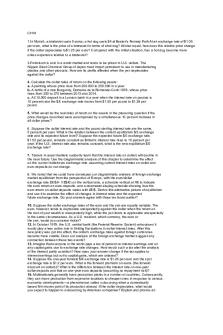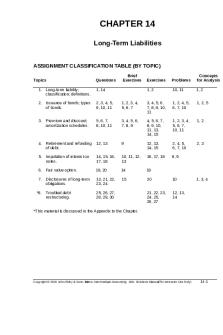Ch14 - ch14 jjjsjssj PDF

| Title | Ch14 - ch14 jjjsjssj |
|---|---|
| Author | Farid Ibrahimov |
| Course | Economy |
| Institution | Kadir Has Üniversitesi |
| Pages | 4 |
| File Size | 190.9 KB |
| File Type | |
| Total Downloads | 53 |
| Total Views | 159 |
Summary
ch14 jjjsjssj...
Description
CH14 1.In Munich, a bratwurst costs 5 euros; a hot dog costs $4 at Boston’s Fenway Park.At an exchange rate of $1.05 per euro, what is the price of a bratwurst in terms of ahot dog? All else equal, how does this relative price change if the dollar depreciates to$1.25 per euro? Compared with the initial situation, has a hot dog become more orless expensive relative to a bratwurst? 3.Petroleum is sold in a world market and tends to be priced in U.S. dollars. The Nippon Steel Chemical Group of Japan must import petroleum to use in manufacturing plastics and other products. How are its profits affected when the yen depreciates against the dollar? 4. Calculate the dollar rates of return on the following assets: a. A painting whose price rises from 200.000 to 250.000 in a year. b. A bottle of a rare Burgundy, Domaine de la Romanée-Conti 1978, whose price rises from 250 to 275 between 2013 and 2014. c. A £10,000 deposit in a London bank in a year when the interest rate on pounds is 10 percent and the $/£ exchange rate moves from $1.50 per pound to $1.38 per pound. 5. What would be the real rates of return on the assets in the preceding question if the price changes described were accompanied by a simultaneous 10 percent increase in all dollar prices? 6. Suppose the dollar interest rate and the pound sterling interest rate are the same, 5 percent per year. What is the relation between the current equilibrium $/£ exchange rate and its expected future level? Suppose the expected future $/£ exchange rate, $1.52 per pound, remains constant as Britain’s interest rate rises to 10 percent per year. If the U.S. interest rate also remains constant, what is the new equilibrium $/£ exchange rate? 7. Traders in asset markets suddenly learn that the interest rate on dollars will decline in the near future. Use the diagrammatic analysis of this chapter to determine the effect on the current dollar/euro exchange rate, assuming current interest rates on dollar and euro deposits do not change. 8. We noted that we could have developed our diagrammatic analysis of foreign exchange market equilibrium from the perspective of Europe, with the euro/dollar exchange rate E€/$(= 1/E$/€) on the vertical axis, a schedule vertical at R€ to indicate the euro return on euro deposits, and a downward-sloping schedule showing how the euro return on dollar deposits varies with E€/$. Derive this alternative picture of equilibrium and use it to examine the effect of changes in interest rates and the expected future exchange rate. Do your answers agree with those we found earlier? 10. Suppose the dollar exchange rates of the euro and the yen are equally variable. The euro, however, tends to depreciate unexpectedly against the dollar when the return on the rest of your wealth is unexpectedly high, while the yen tends to appreciate unexpectedly in the same circumstances. As a U.S. resident, which currency, the euro or the yen, would you consider riskier? 12. In October 1979, the U.S. central bank (the Federal Reserve System) announced it would play a less active role in limiting fluctuations in dollar interest rates. After this new policy was put into effect, the dollar’s exchange rates against foreign currencies became more volatile. Does our analysis of the foreign exchange market suggest any connection between these two events? 13. Imagine that everyone in the world pays a tax of percent on interest earnings and on any capital gains due to exchange rate changes. How would such a tax alter the analysis of the interest parity condition? How does your answer change if the tax applies to interest earnings but not to capital gains, which are untaxed? 14. Suppose the one-year forward $/€ exchange rate is $1.26 per euro and the spot exchange rate is $1.2 per euro. What is the forward premium on euros (the forward discount on dollars)? What is the difference between the interest rate on one-year dollar deposits and that on one-year euro deposits (assuming no repayment risk)? 16. Multinationals generally have production plants in a number of countries. Consequently, they can move production from expensive locations to cheaper ones in response to various economic developments—a phenomenon called outsourcing when a domestically based firm moves part of its production abroad. If the dollar depreciates, what would you expect to happen to outsourcing by American companies? Explain and provide an
example.
1.At an exchange rate of 1.05 $ per euro, a 5 euro bratwurst costs 1.05$/euro ⋅ 5 euros = $5.25. Thus, the bratwurst in Munich is $1.25 more expensive than the hot dog in Boston. The relative price is $5.25/$4 = 1.31. A bratwurst costs 1.31 hot dogs. If the dollar depreciates to 1.25$/euro, the bratwurst now costs 1.25$/euro ⋅ 5 euros = $6.25, for a relative price of $6.25/$4 = 1.56. You have to give up 1.56 hot dogs to buy a bratwurst. Hot dogs have become relatively cheaper than bratwurst after the depreciation of the dollar. 3. profits decrease because you have to spend more yen per dollar so for international buyers, the products are cheaper, so its profits will increase 4. The dollar rates of return are as follows: a. ($250,000 − $200,000)/$200,000 = 0.25. b. ($275 − $255)/$255 = 0.08 c. There are two parts to this return. One is the loss involved due to the appreciation of the dollar; the dollar appreciation is ($1.38 − $1.50)/$1.50 = −0.08. The other part of the return is the interest paid by the London bank on the deposit, 10 percent. (The size of the deposit is immaterial to the calculation of the rate of return.) In terms of dollars, the realized return on the London deposit is thus 2 percent per year. 5. a. The real return on the painting would be 25% - 10% = 15%. This return could also be calculated by first finding the portion of the $50,000 increase in the painting’s price due to inflation ($20,000), then finding the portion of the nominal increase dueto real appreciation ($30,000), and finally finding the appropriate real rate of return($30,000/$200,000 = 0.15). b. Again, subtracting the inflation rate from the nominal return, we get 20% - 10% =10%. c. 2% - 10%=-8%. 6. The current equilibrium exchange rate (Et ) must equal its expected future level (E^e t+1 ) since, with equality of nominal interest rates, there can be no expected increase or decrease in the dollar/pound exchange rate in equilibrium. If the expected exchange rate remains at $1.52 per pound and the pound interest rate rises to 7 percent, then interest parity is satisfied only if the current exchange rate changes such that there is an expected appreciation of the dollar equal to 4 percent. This will occur when the exchange rate rises to $1.583 per pound (a depreciation of the dollar against the pound). 7. If market traders learn that the dollar interest rate will soon fall, they also revise upward their expectation of the dollar’s future depreciation in the foreign-exchange market. Given the current exchange rate and interest rates, there is thus a rise in the expected dollar return on euro deposits. The downward-sloping curve in the diagram below shifts to the right and there is an immediate dollar depreciation, as shown in the figure below where a shift in the interestparity curve from II to II leads to a depreciation of the dollar from E0 to E1.
12. Greater fluctuations in the dollar interest rate lead directly to greater fluctuations in the exchange rate using our model described in the lectures. The movements in the interest rate can be investigated by shifting the vertical interest rate curve. As shown in the Figure below, these movements lead directly to movements in the exchange rate. For example, an increase in the interest rate from i to i leads to a dollar appreciation from E to E. A decrease in the interest rate from i to i leads to a dollar depreciation from E to E. This diagram demonstrates
the direct link between interest rate volatility and exchange rate volatility, given that the expected future exchange rate does not change.
8.
10. The euro-denominated assets are less risky for you. When the rest of your wealth falls,the euro tends to appreciate, cushioning your losses by giving you a relatively highpayo ↵in terms of dollars.Losses on your euro assets, on the other hand, tend tooccur when they are least painful, that is, when the rest of your wealth is unexpectedlyhigh.Holding the euro therefore is a better instrument to diversify your investmentsince it reduces the variability of your total wealth. 13. A tax on interest earnings and capital gains leaves the interest parity condition the same, since all its components are multiplied by one less the tax rate to obtain after-tax returns. If capital gains are untaxed, the expected depreciation term in the interest parity condition must be divided by 1 less the tax rate. The component of the foreign return due to capital gains is now valued more highly than interest payments because it is untaxed. 14.The forward premium on euro is (1.26 - 1.20)/1.20 = 0.05. The interest rate di↵erencebetween one-year dollar deposits and one-year euro deposits will be 5 percent becausethe interest di↵erence must equal the forward premium on euro against dollars whencovered interest parity holds 16. If dollar depreciates, it becomes cheaper compared to other currencies. This makes US labor cheaper, and will make companies more willing to buy for US based things, like labor. This would mean that companies from the US that were going to outsource will find it less appealing to outsource.
Basically, the US becomes cheaper than it was, which means outsourcing goes down....
Similar Free PDFs

Ch14 - ch14 jjjsjssj
- 4 Pages

ch14 Test
- 42 Pages

CH14 Directors
- 25 Pages

CH14 - test
- 69 Pages

2760(Ch14)(Conjugated Systems)
- 2 Pages

CH14-Market Planning - For POM
- 35 Pages

14 maci soc9c tif ch14
- 20 Pages

Income Tax Banggawan 2019 Ch14
- 12 Pages

Ch14 Test - ugh
- 42 Pages

Ch14 - Practice Questions
- 9 Pages

Ch14 - Chapter solutions
- 97 Pages

L2 Solutions Ch14
- 2 Pages

Yates ch14 - test bank
- 44 Pages

Principles of marketing CH14
- 52 Pages

Ch14 - TEST BANK
- 78 Pages

Review Questions Ch14
- 7 Pages
Popular Institutions
- Tinajero National High School - Annex
- Politeknik Caltex Riau
- Yokohama City University
- SGT University
- University of Al-Qadisiyah
- Divine Word College of Vigan
- Techniek College Rotterdam
- Universidade de Santiago
- Universiti Teknologi MARA Cawangan Johor Kampus Pasir Gudang
- Poltekkes Kemenkes Yogyakarta
- Baguio City National High School
- Colegio san marcos
- preparatoria uno
- Centro de Bachillerato Tecnológico Industrial y de Servicios No. 107
- Dalian Maritime University
- Quang Trung Secondary School
- Colegio Tecnológico en Informática
- Corporación Regional de Educación Superior
- Grupo CEDVA
- Dar Al Uloom University
- Centro de Estudios Preuniversitarios de la Universidad Nacional de Ingeniería
- 上智大学
- Aakash International School, Nuna Majara
- San Felipe Neri Catholic School
- Kang Chiao International School - New Taipei City
- Misamis Occidental National High School
- Institución Educativa Escuela Normal Juan Ladrilleros
- Kolehiyo ng Pantukan
- Batanes State College
- Instituto Continental
- Sekolah Menengah Kejuruan Kesehatan Kaltara (Tarakan)
- Colegio de La Inmaculada Concepcion - Cebu